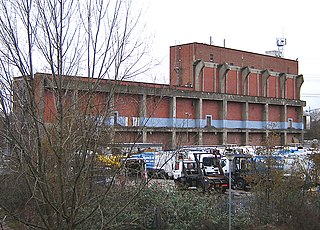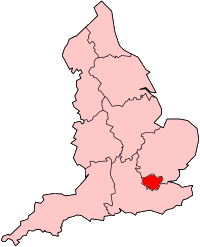
Rye House Power Station is a 715 MW combined cycle gas turbine (CCGT) power station located near Rye House railway station in Hoddesdon, Hertfordshire.

The Littlebrook Power Station were a series of four oil and coal-fired power stations situated on the south bank of the River Thames, next to the Queen Elizabeth 2 Bridge and the Dartford Tunnel in Dartford, Kent. The final power station, Littlebrook D, ceased operating in March 2015, and has now been demolished.

West Ham Power Station was a coal-fired power station on Bow Creek at Canning Town, in east London. It was often referred to informally as Canning Town Power Station.

Three distinct coal-fired power stations were built at Deptford on the south bank of the River Thames, the first of which is regarded as the first central high-voltage power station in the world.

Peterborough Power Station is a 360MW gas-fired power station at Eastern Industry, Fengate in the city of Peterborough, Cambridgeshire in the United Kingdom. It employs around forty people.

Little Barford Power Station is a gas-fired power station just north of the village of Little Barford in Bedfordshire, England. It lies just south of the A428 St Neots bypass and east of the Wyboston Leisure Park. The River Great Ouse runs alongside. It was formerly the site of two coal-fired power stations, now demolished. The station is operated by RWE.

Shoreham Power Station is a 420MWe combined cycle gas-fired power station in Southwick, West Sussex. It was built on the site of the Brighton B Power Station.

Staythorpe C Power Station is a 1,735 MWe gas-fired power station at Staythorpe between Southwell and Newark-on-Trent in Nottinghamshire, England, between the River Trent and Nottingham to Lincoln railway line. The station was handed over to the owner RWE from Alstom Power with full commercial operation being achieved in December 2010. The official opening ceremony attended by Charles Hendry, Minister of State took place on 9 May 2011.

The Tilbury power stations were two thermal power stations on the north bank of the River Thames at Tilbury in Essex. The 360 MW dual coal- and oil-fired Tilbury A Power Station operated from 1956 until 1981 when it was mothballed, prior to demolition in 1999. The 1,428 MW Tilbury B Power Station operated between 1968 and 2013 and was fueled by coal, as well as co-firing with oil and, from 2011, biomass. Tilbury B was demolished in 2016–19. Since 2013 three other power stations have been proposed or constructed in Tilbury.

Doncaster Power Station refers to two coal-fired electricity generating stations situated in the centre of Doncaster in South Yorkshire, England. Doncaster A provided electricity to the town from 1900 to 1958, and the B station from 1953 to 1983.
Acton Lane Power Station was a power station in London NW10. The station, also known as Willesden power station, was located to the south of the Euston to Birmingham railway on a site bounded by Acton Lane, the Grand Union Canal and the Dudding Hill railway line. In later years the site was extended to the south side of the canal. The entire site is now occupied by Willesden Grid Supply Point buildings.

Hackney Power Station was a coal-fired power station situated at Lea Bridge on the River Lee Navigation in London.
Ocker Hill Power Station was situated at Ocker Hill in Tipton, Staffordshire, at a point where the Walsall Canal intersected the L&NWR Wednesbury to Princes End railway line. It was opened in 1902 by the Midland Electric Corporation for Power Distribution Limited (MEC) and supplied electricity at 7 kV two phase 50 Hz to much of the Black Country. At the time of its building it was stated by the Stourbridge County Express that it was planned to be the largest power station in England. Although this may have been the original intention, it was never achieved.

Foss Island Power Station, also known as York Power Station, was a small 40 MW coal-fired power station serving the city of York.
Watford Power Station was a coal-fired power station situated in Watford's Riverside area. The station was built by the Watford Corporation Electricity Department starting with the installation of cables in 1899 with completion around 1900, near the banks of the River Colne. A gas turbine power station was commissioned in 1980.
The Norwich power stations were a sequence of electricity generating stations that provided electric power to the City of Norwich and the wider area between 1893 and 1986. The first station in Duke Street began operating in 1893, a new power station at Thorpe was in service from 1926 to 1967, this was supplemented with a 'high pressure' station, 1937–1975, and finally a gas turbine station operated from 1964–1986.
Blackburn power stations are a series of electricity generating stations that have provided electric power to the town of Blackburn and the wider area from 1895 to the present. The first station in Jubilee Street, Blackburn began operating in 1895. A new larger station known as Blackburn East or Whitebirk power station was commissioned in 1921 and was rebuilt in stages over the period 1942 to 1955. Whitebirk station closed in 1976. The 60 MW Blackburn Mill Combined Cycle Gas Turbine (CCGT) power station has generated electricity since 2002. The Blackburn energy from waste (EfW) plant is currently (2020) being planned.
The Lancaster power stations provided electricity to the Lancashire town and city of Lancaster and the surrounding area from 1894 to 1976. The first power station was built and operated by Lancaster Corporation and started generating electricity in April 1894. The second power station was built during the First World War near the Lune Aqueduct to provide electric power for a munitions factory. When the factory closed after the war the power station was purchased by the corporation to provide electric power throughout its supply area.
The Percival Lane power station in Runcorn was built and operated by the Mersey Power Company Limited. It comprised two stations A and B commissioned in 1921 and 1941. The station supplied electricity to commercial, industrial and domestic users over a wide area of 95 square miles around the River Mersey including Widnes, Ellesmere Port and Runcorn.
The Thornhill power station generated and supplied electricity to the town of Dewsbury and the wider regional area from 1902 to 1982, and again from 1998. The first generating station on the site was owned and operated by the Yorkshire Electric Power Company. Following nationalisation of the British electricity supply industry in 1948 Thornhill power station was operated by a succession of state owned bodies. The power station was redeveloped with new plant in 1915, 1925, 1932–37 and 1950–54. The coal-fired steam station was decommissioned in 1982, and was subsequently demolished. A gas turbine power station on the site was commissioned in 1998.














